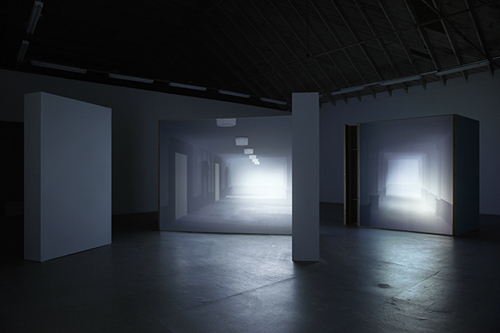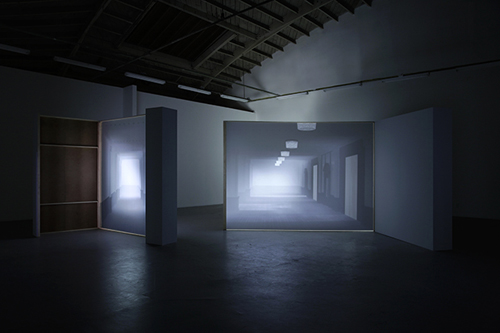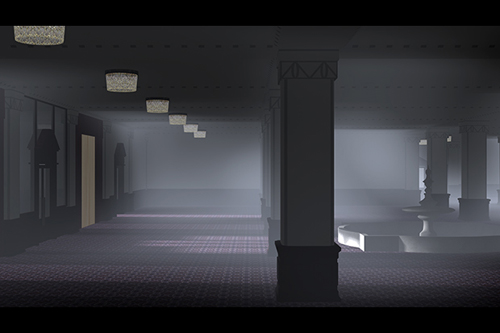[2007–2008] Double Location (The Ambassador Hotel)
Wood construction, paint, two projection screens, three computer-generated animations transferred to DVD, one 16:9 monitor
Dimensions variable (approx. 200 x 520 x 225 cm)
Descriptions of space in film and television productions play an important role not only on the construction of realities, but also on our rendering of memory and history. Films transform real places into their fictional representations, and at the same time they contribute to the fictionalization of actual spaces. The project Double Location aims toward a new form of visual history, one that deals with the depiction of historic spaces and their recollection in a media-based society.
The Ambassador Hotel—built in 1921 and torn down in 2006—served as centerpiece for the urban development of Wilshire Boulevard, one of the most important east-west corridors found in Los Angeles. Furthermore, it was also linked to the history of the Golden Age of Hollywood, with its popular Coconut Grove Nightclub, and by serving as location for the first Academy Award Ceremonies. In 1968, however, it received more negative fame, when Robert Kennedy was assassinated in the hotel's kitchen. After the hotel was shut down in 1989, it was exclusively used as movie set for film and television productions, and ranged among the most widely used movie sets in Los Angeles.
Double Location (The Ambassador Hotel) uses this history in order to reconstruct the famous hotel lobby; the reconstruction is not, however, an objective architectural scale model based on documentary material, but instead a virtual space grounded in media transported descriptions of space found throughout a multiplicity of Hollywood films. In contrast to current trends in popular historiography that use computer-generated simulations to claim historical authenticity, the method used for Double Location is not intended to recreate the past by aiming to fill visual gaps. It reacts upon the perception and recollection of the real space of the hotel by considering the hotel's afterlife on celluloid, reflecting the fragmentary memory of spaces left by Hollywood films. Designed as active sculptural space and linking physical and virtual levels of perception, the installation reevaluates one's relation to mediated images and conventions.
"[...] (This) three-dimensional enactment—in the form of a walk-in space consisting of projections that, in turn, constitutes a stage-like situation—not only shows us as viewers that the documentary-style computer animation of the hotel lobby is the product of both real and imaginary associations; rather, this conveys in a very 'real' way that 'being on site' implies moving through a series of image spaces—through images of images of images, that include the exhibition space itself and our movement through it. They are visual feedback loops that express our current understanding of 'reality', of an experience of place and 'being on site'. [...]" - Rike Frank
< Index



